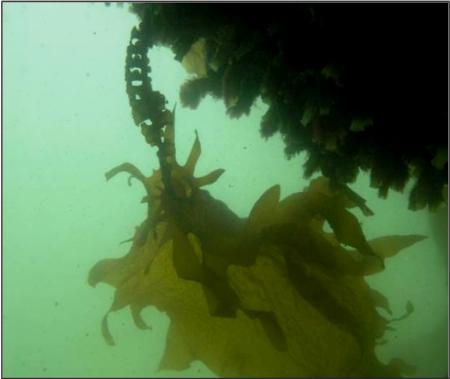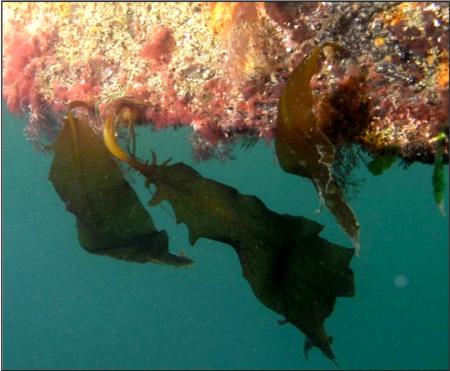Asian Kelp
-
Scientific Name
Undaria pinnatifida - Visit algaeBASE for full scientific classification.
-
Description
 Undaria pinnatifida. Photo by Carrie Culver © 2008 Regents, University of California.
Undaria pinnatifida. Photo by Carrie Culver © 2008 Regents, University of California. Undaria pinnatifida. © 2007 Jessie Altstatt
Undaria pinnatifida. © 2007 Jessie Altstatt- Large golden-brown seaweed, 3 to 9 feet long.
- A root-like structure, the holdfast, attaches the plant to hard surfaces.
- Mature blades have finger-like marginal lobes.
- A spiral, ruffled reproductive structure, the sporophyll, grows between the holdfast and the blade.
-
Habitat
- Found in temperate coastal waters in low intertidal and subtidal areas.
- Grows on a wide range of natural and man-made structures, often forming dense stands.
-
Invasion Pathways and Distribution
- Grown for human consumption in its native range in Japan, China and Korea.
- Transported accidentally through oyster aquaculture and attached to vessel hulls.
- Now found in Australia, New Zealand, southern Atlantic and Mediterranean Europe, Argentina, Baja California, Mexico and California, where it occurs in ports and harbors from San Diego to San Francisco; one offshore population at Santa Catalina Island.
- First reported in California in 2000.
-
Life History
- Annual, with two independent life stages.
- The sporophyte stage (the large kelp), present in the spring and summer months, releases spores that settle and develop into a microscopic gametophyte stage that produces sperm and eggs.
- Fertilization results in a new sporophyte, with holdfast and blade.
-
Impacts
- Grows quickly to a large size, and may compete with native seaweeds.
- May become a pest, fouling harbors and damaging infrastructure.
-
References and Useful Links
For references by category and links to other useful AIS sites see our LEARN MORE page.


